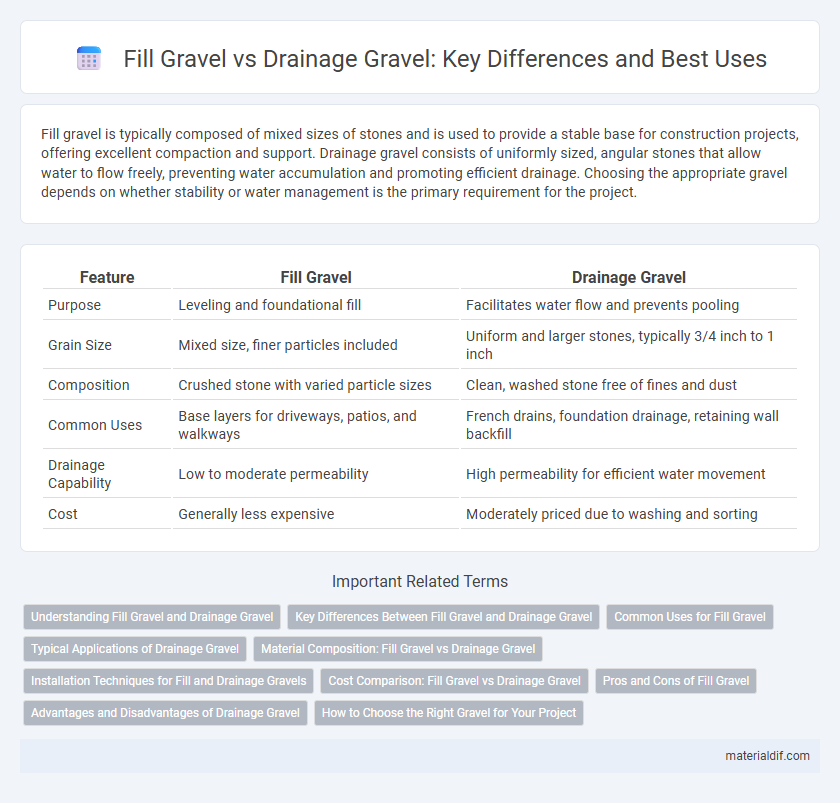Fill gravel is typically composed of mixed sizes of stones and is used to provide a stable base for construction projects, offering excellent compaction and support. Drainage gravel consists of uniformly sized, angular stones that allow water to flow freely, preventing water accumulation and promoting efficient drainage. Choosing the appropriate gravel depends on whether stability or water management is the primary requirement for the project.
Table of Comparison
| Feature | Fill Gravel | Drainage Gravel |
|---|---|---|
| Purpose | Leveling and foundational fill | Facilitates water flow and prevents pooling |
| Grain Size | Mixed size, finer particles included | Uniform and larger stones, typically 3/4 inch to 1 inch |
| Composition | Crushed stone with varied particle sizes | Clean, washed stone free of fines and dust |
| Common Uses | Base layers for driveways, patios, and walkways | French drains, foundation drainage, retaining wall backfill |
| Drainage Capability | Low to moderate permeability | High permeability for efficient water movement |
| Cost | Generally less expensive | Moderately priced due to washing and sorting |
Understanding Fill Gravel and Drainage Gravel
Fill gravel consists of a mixture of various-sized stones and is primarily used as a base layer for construction projects due to its ability to provide stability and support. Drainage gravel is characterized by uniform, rounded stones that allow water to flow freely, making it ideal for preventing water accumulation in landscaping and foundation drainage systems. Understanding the specific properties and applications of fill gravel and drainage gravel ensures proper selection for structural integrity and effective water management.
Key Differences Between Fill Gravel and Drainage Gravel
Fill gravel consists of mixed-size, often angular stones used primarily for foundational support and leveling in construction projects, providing stability and preventing settling. Drainage gravel features uniformly sized, rounded stones designed to facilitate water flow and prevent water accumulation in drainage systems, such as French drains and retaining wall backfills. The key difference lies in particle size and shape: fill gravel prioritizes compaction and load-bearing capacity, while drainage gravel enhances permeability and water movement.
Common Uses for Fill Gravel
Fill gravel is commonly used as a stable base layer for construction projects, including roadways, driveways, and foundations, due to its excellent compaction and load-bearing properties. It provides essential support that prevents settling and shifting in structures by evenly distributing weight and facilitating drainage. Unlike drainage gravel, which is designed primarily to channel water away, fill gravel focuses on stabilizing the soil and improving overall ground strength.
Typical Applications of Drainage Gravel
Drainage gravel is primarily used in applications requiring efficient water flow and filtration, such as around foundation footings, under French drains, and in retaining wall drainage systems. Its angular shape and consistent size allow water to easily pass through while preventing soil erosion and clogging. This type of gravel is essential in landscape drainage and septic system leach fields to manage water runoff and prevent flooding.
Material Composition: Fill Gravel vs Drainage Gravel
Fill gravel primarily consists of mixed-size, irregularly shaped stones, often including sand, silt, and clay, designed for compaction and stability in construction projects. Drainage gravel is typically composed of uniformly sized, clean, washed stones such as crushed rock or pea gravel, facilitating optimal water flow to prevent pooling and erosion. The material composition directly impacts functionality, with fill gravel providing foundational support and drainage gravel enhancing water permeability in landscaping and drainage systems.
Installation Techniques for Fill and Drainage Gravels
Installation techniques for fill gravel emphasize layering and compaction to provide a stable base for construction, often involving the use of heavy machinery to achieve maximum density. Drainage gravel installation requires creating a well-graded, coarse aggregate layer that promotes water flow and prevents soil erosion, typically incorporating geotextile fabric to maintain separation from surrounding soil. Proper installation of both fill and drainage gravels ensures structural integrity and effective water management on construction sites.
Cost Comparison: Fill Gravel vs Drainage Gravel
Fill gravel typically costs less per ton compared to drainage gravel due to its lower processing requirements and larger particle size. Drainage gravel, often composed of washed and sorted aggregates, incurs higher expenses because of enhanced filtration properties vital for water management systems. Choosing between fill gravel and drainage gravel depends on the project's budget constraints and specific functionality needs, with drainage gravel commanding a premium price for performance benefits.
Pros and Cons of Fill Gravel
Fill gravel offers excellent stability and compaction for construction projects, making it ideal for creating solid foundations and preventing soil erosion. However, it can retain moisture, which may lead to drainage issues and potential structural problems if not managed properly. Unlike drainage gravel, fill gravel lacks optimal perforation and size variation needed to facilitate water flow, limiting its effectiveness in water management applications.
Advantages and Disadvantages of Drainage Gravel
Drainage gravel offers superior water flow management due to its uniform size and shape, reducing water pooling and soil erosion around foundations and landscaping. Its advantages include enhanced drainage efficiency and long-term durability in preventing water accumulation, though it can be more expensive and less visually appealing compared to standard fill gravel. Disadvantages involve limited load-bearing capacity and potential clogging over time if fine sediments infiltrate the drainage system.
How to Choose the Right Gravel for Your Project
Fill gravel is primarily composed of crushed stone or gravel mixed with fines, making it ideal for creating a stable base for construction projects such as driveways and foundations. Drainage gravel consists of larger, clean stones that allow water to flow freely, making it essential for drainage systems and preventing water buildup. Selecting the right gravel depends on the project's purpose: choose fill gravel for structural support and compaction, and drainage gravel where water flow and filtration are priorities.
Fill Gravel vs Drainage Gravel Infographic

 materialdif.com
materialdif.com